-

小学语文五年级上册第1课《草原》优秀教案范文
初读课文,学习字词。 1.提出读书要求:默读课文,一边读一边画出不认识的字和不理解的词,并借助词典等学习工具书理解。 2.教师检查学生学习情况。 (1)检查生字读音。 小丘( qiū)渲染(xuàn )迂回( yū)蒙古包( měng ) 襟飘带舞( jīn )鄂温克(è) (2)指导易混淆的字。 “襟”是左右结构,左边是“衤”,与衣服有关,表示衣服胸前的部分。 “涩”是左右结构,右边下面是“止”,不能写成“上”。 “裳”下面是“衣”,与衣服有关。 “微”:中间部分不能少一横。 (3)理解较难的词语。 ①联系上下文理解词语。 草原上行车十分洒脱,只要方向不错,怎么走都可以。 “洒脱”的意思是:潇洒自然,不拘束。这个词语反映了草原的广阔无边。 ②理解“襟飘带舞”一词的意思,可以出示蒙古族鲜艳的服装来分析,意思是:衣襟和裙带随风舞动。 ③“翠色欲流”一词可以从难字入手理解,比如“欲”在这里表示“将要”的意思,“翠色欲流”就是绿得太浓了,将要流下来,写出了草原的绿,是充满生命力的。 ④鄂温克:我国少数民族之一,聚居在内蒙古自治区的东北部。

一年级下册朗文1B 介词主题教案
知识与技能To teach the words in the house : sofa table chair box cupboard shelf . Pron. on in under near

中班音乐教案:唐老鸭减肥记
活动目标:1、通过故事情节,帮助幼儿感受理解音乐三段体的变化过程。2、初步学习合拍地做胖鸭走、瘦鸭走以及做运动的动作。3、能根据音乐的节奏及乐句变化创编健身动作及图谱。4、感受音乐活动带来的快乐,知道肥胖会给人的活动带来不方便,我们应提倡合理饮食,运动健身。 活动准备:音乐《瑞典狂想曲》片段(前半段)、图片(胖鸭、瘦鸭)、小图谱纸人手一份,绘画笔人手一支活动过程:

中班数学:小王子历险记课件教案
活动目标: (一)按样式规律进行直线、圆形排列,尝试多种变化的样式。 (二)通过讨论,集体或小组解决故事中遇到的问题。 (三)充分发挥孩子喜欢故事的天性,把故事中有用的办法运用到日常生活中。 活动准备: 圆形底盘、故事情节中涉及到的人物、建筑造型、彩色积木块。 活动过程: 一、铺设直线:城堡前的小路1、引言:美丽的城堡里,住着一位漂亮的公主,城堡对面的小王子,深爱着这位公主。

中班艺术:时装表演课件教案
目标:1.能大胆在集体前表演,感受表演的快乐,体验成功的喜悦。2.通过亲身体验初步了解上台表演前的准备工作。 准备:化妆品,服饰,头饰,镜子,项链,磁带,录音机 过程: 一.参观图片展小朋友,我们一起去看一个图片展览会!提问1、照片上的小朋友在做什么?对,他们有的在跳舞,有的在唱歌,他们在表演节目。

中班语言课件教案: 蒲公英妈妈和小蚂蚁
2、进一步培养幼儿的口语表达能力。二、活动准备: 背景图一张;磁性教具:四只蚂蚁 树叶 小船 一条大青虫 四个小伞兵;蚂蚁头饰数量和幼儿人数一样多;蒲公英、青虫头饰各一个;配乐故事磁带。活动过程:(一)出示“蚂蚁”,引出主题。1、看,它是谁?(小蚂蚁)你们喜欢小蚂蚁吗?2、今天我就来讲一个小蚂蚁的故事。故事的名字叫蒲公英妈妈和小蚂蚁。(二)欣赏故事《蒲公英妈妈和小蚂蚁》。1、教师有表情的讲述故事。讲述故事后提问:1)故事的名字叫什么?2)故事里有谁和谁?2、出示背景图,教师边演示教具边讲故事。讲述过程中提问:1)小河的对岸住着谁?2)一阵大风吹来,小蚂蚁坐的树叶小船怎么了?3)野地里有什么?它是什么样子的?4)蒲公英是怎样对待小蚂蚁的?5)小蚂蚁说了些什么?蒲公英妈妈又说了些什么?6)蒲公英妈妈为什么很感激小蚂蚁?7)小蚂蚁是怎样回到自己家的?8)这个故事告诉了我们一个什么道理?

小学语文修辞手法教案专题课件
1、明喻: 明喻就是本体、喻体和比喻词都出现的比喻。例句:例如:长城像一条长龙。这个句子中,“长城”是本体,“像”是比喻词,“一条长龙”是喻体。2、暗喻: 暗喻又叫隐喻,只出现本体和喻体,不用比喻词语或用“是、变成、成为、等于”等喻词。例句:例如:山间的云雾构成了一幅精妙的山水画。这个句子中“山间的云雾”是本体,“构成”是比喻词,“一幅精妙的山水画”是喻体。3、借喻: 借喻是只出现用来代替本体的喻体,而本体和喻词都不出现。例句:落光了叶子的柳树上挂满了毛茸茸、亮晶晶的银条儿。这个句子中,本体、比喻词均没有出现,喻体是“银条儿”。
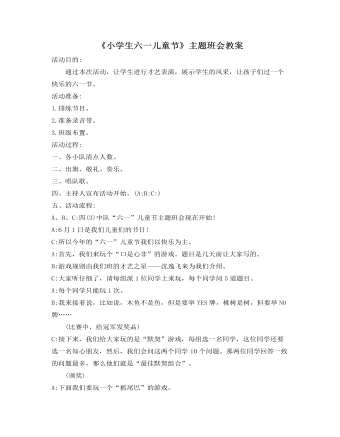
《小学生六一儿童节》主题班会教案
活动目的:通过本次活动,让学生进行才艺表演,展示学生的风采,让孩子们过一个快乐的六一节。活动准备:1.排练节目。2.准备录音带。3.班级布置。活动过程:一、各小队清点人数。二、出旗、敬礼、奏乐。三、唱队歌。四、主持人宣布活动开始。(A:B:C:)五、活动流程:A、B、C:四(3)中队“六一”儿童节主题班会现在开始!A:6月1日是我们儿童们的节日!C:所以今年的“六一”儿童节我们以快乐为主。A:首先,我们来玩个“口是心非”的游戏。题目是几天前让大家写的。B:游戏规则由我们班的才艺之星——沈逸飞来为我们介绍。C:大家听仔细了,请每组派1位同学上来玩,每个同学问5道题目。A:每个同学只能玩1次。B:我来接着说,比如说,木鱼不是鱼,但是要举YES牌,桃树是树,但要举NO牌……
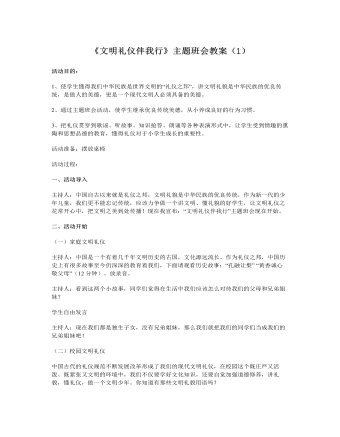
《文明礼仪伴我行》主题班会教案(1)
(一)家庭文明礼仪主持人:中国是一个有着几千年文明历史的古国,文化源远流长。作为礼仪之邦,中国历史上有很多故事至今仍深深的教育着我们,下面请观看历史故事:“孔融让梨” “黄香诚心敬父母”(12分钟)。放录音。主持人:看到这两个小故事,同学们觉得在生活中我们应该怎么对待我们的父母和兄弟姐妹?学生自由发言主持人:现在我们都是独生子女,没有兄弟姐妹,那么我们就把我们的同学们当成我们的兄弟姐妹吧!(二)校园文明礼仪中国古代的礼仪规范不断发展改革形成了我们的现代文明礼仪,在校园这个既庄严又活泼、既紧张又文明的环境中,我们不仅要学好文化知识,还要自觉加强道德修养,讲礼貌,懂礼仪,做一个文明少年。你知道有那些文明礼貌用语吗?
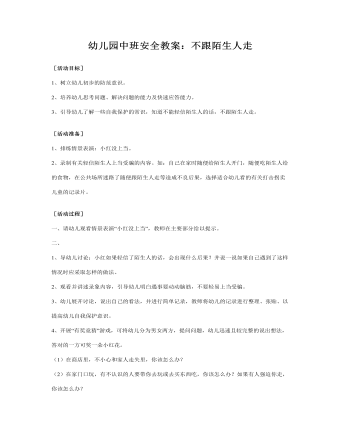
幼儿园中班安全教案:不跟陌生人走
2、培养幼儿思考问题、解决问题的能力及快速应答能力。 3、引导幼儿了解一些自我保护的常识,知道不能轻信陌生人的话,不跟陌生人走。[活动准备] 1、排练情景表演:小红没上当。 2、录制有关轻信陌生人上当受骗的内容。如:自己在家时随便给陌生人开门,随便吃陌生人给的食物,在公共场所迷路了随便跟陌生人走等造成不良后果,选择适合幼儿看的有关打击拐卖儿童的记录片。[活动过程]一、请幼儿观看情景表演“小红没上当”,教师在主要部分给以提示。

部编版语文九年级下册《短文两篇》教案
4.《不求甚解》一文分析了陶渊明怎样的读书态度,请指出“不求甚解”的两层含义。明确:态度:养成“好读书”的习惯;读书要诀在于“会意”。含义:第一,虚心,书不一定都能读懂;第二,读书方法:不固执一点,而要了解大意。5.《不求甚解》一文是驳论文还是立论文?又是如何驳或者立的?谈一谈你的理解。明确:驳论文。驳的是“论点”,先全面阐述“不求甚解”的含义,进而提倡虚心的“不求甚解”的读书态度,从而表明自己的观点;又从“会意”角度,列举古人读书的例子,并阐明自己的正确论点:读书在会意,不要死抠字眼,为一个局部而放弃整体;最后又强调了“书必须反复读”的主张。这样通过树立自己正确的观点从而驳倒敌论。
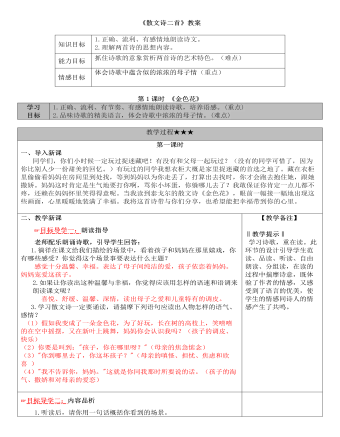
部编版语文七年级上册《散文诗二首》教案
?目标导学三:拓展延伸 1.请你模仿例句仿写。例句:母亲啊!你是荷叶,我是红莲,心中的雨点来了,除了你,谁是我在无遮拦天空下的荫蔽? 仿写: 示例一 :母亲啊,你是流水,我是鱼儿,当干旱来临时,除了你,谁还能为我提供一个安定的家?示例二:母亲啊,你是避风港,我是小船,狂风暴雨来临时,除了你,谁是我在无遮拦大海中的依靠? 示例三:母亲啊,你是鸟巢,我是小鸟,心中的寒冷来了,除了你,谁是我在冷风中的温暖? 2. 人说:天下的母亲有着不一样的面容,但唯有一样——母爱,是完全一样的。同学们,我们享受母爱十余载,那么你们的母亲是如何保护、关爱你们的呢?

部编版语文八年级上册《散文两篇》教案
目标导学三:理解课文,把握内涵1.作者为什么把追求爱情作为活着的第一条理由?明确:作者说,追求爱情,有三方面的原因:第一,爱情可以带来狂喜;第二,爱情可以解除孤寂;第三,爱情的结合可以使人看到想象的仙境的神秘缩影。总之,爱情使人生活得更加美好;追求爱情,则是追求人生的境界。在这里,作者把爱情描写得极其美好,闪耀着人性的光辉。2.作者为什么追求知识?你能说说知识给你带来了什么吗?明确:一是可以了解人的心灵;二是可以了解星辰为什么发光;三是能够理解毕达哥拉斯的思想威力。这三方面实际上包含了人类知识的几个重要方面:人类、自然和社会。事实上,我们学习的知识,是人类在对世界的好奇心驱使下的创造,它给我们带来的不仅有解开世界之谜的快乐,还有思考过程本身的快乐。

部编版语文九年级下册《短文两篇》教案
4.《不求甚解》一文分析了陶渊明怎样的读书态度,请指出“不求甚解”的两层含义。明确:态度:养成“好读书”的习惯;读书要诀在于“会意”。含义:第一,虚心,书不一定都能读懂;第二,读书方法:不固执一点,而要了解大意。5.《不求甚解》一文是驳论文还是立论文?又是如何驳或者立的?谈一谈你的理解。明确:驳论文。驳的是“论点”,先全面阐述“不求甚解”的含义,进而提倡虚心的“不求甚解”的读书态度,从而表明自己的观点;又从“会意”角度,列举古人读书的例子,并阐明自己的正确论点:读书在会意,不要死抠字眼,为一个局部而放弃整体;最后又强调了“书必须反复读”的主张。这样通过树立自己正确的观点从而驳倒敌论。

部编人教版四年级下册《文言文二则》创新教案
三、教学过程(一)导入新课:1.师:同学们,中国是世界上历史最悠久的国家之一,在漫漫的历史长河中,产生了大量的神话传说和历史故事,后来人们把这些神话传说和历史故事加以锤炼,便形成了许多脍炙人口的成语。下面,让我们一起来感受下中华语言文化的精华,背诵下我们积累的成语。)2.学生起头,背诵成语接龙。(在今后的学习中我们还会积累更多的成语,希望同学们继续保持这种学习精神。)3.导入:成语是我国语言文化的精华,它们有的庄重严肃,有的机智幽默,而且大多数的成语背后都有一个生动的故事。今天老师给大家带来个有趣的成语故事,大家想不想看?这个成语故事的名字叫做“铁杵成针”。(板书课题:铁杵成针)不过,老师有个要求,希望同学们能带着这些问题认真去观看。

部编人教版四年级下册《文言文二则》教案
一、谈话交流,导入课题。1.同学们,《凿壁偷光》的故事大家听说过吗?【课件出示2:图文】匡衡勤奋好学,可是家境贫寒,晚上想读书而无烛照明。邻居家倒是每到夜晚,总烛光明亮,可惜这光照不到他匡衡的屋里。怎么办呢?匡衡便把自己家靠邻舍的那堵墙壁凿开一个洞以引邻居家的烛光来读书。古时候,还有一位热爱读书的人,他是晋代车胤,因为家贫,没钱买灯油,而又想晚上读书,便在夏天晚上抓一把萤火虫来当灯读书。2.这个故事就是《囊萤夜读》,今天,我们来学习一下这个小故事。(板书:囊萤夜读)学生齐读课题。3.这是一篇文言文。千古传诵,流传至今。4.补充文言文知识:文言文人们通常说古文。我国是一个文明古国,我国古代有着灿烂的文化,有着浩如烟海的文学艺术瑰宝,他们都是以文言文的形式记载下来的。我们要去传承民族的瑰宝,就要学好文言文。【课件出示3】

部编版语文八年级上册《写作:语言要连贯》教案
(3)也可以用散文的形式将某一个传统节日的历史渊源娓娓道来,从宏观层面追溯千年历史。2.佳作欣赏节 日在一阵阵爆竹声中,一阵阵欢歌笑语中,我们终于迎来了春节!春节,是中国最盛大的节日,也是我们最高兴的日子。家家张灯结彩,街面上修饰一新,一派喜气洋洋的景象。爸爸妈妈也早早地把家里布置一新,置办了年货,我幸福地眨着眼睛,穿着新衣服在大衣柜镜子前照来照去,真是美极了!大年三十,爸爸领着我把鲜红的对联贴在院门上,那喜庆的金字映衬得我家满院都生辉了。最温馨的是除夕晚上,全家围坐在一起吃着香气四溢的年夜饭,看着异彩纷呈的春晚节目……心中感到是那样的温暖。

部编版语文七年级上册《世说新语》二则教案
?目标导学二:理解内容,体会写法 1.文章开头一句“谢太傅寒雪日内集,与儿女讲论文义。”这句话在全文中有什么作用? 涵盖事件时间、地点、人物及主体事件等丰富的内容。正因为“寒雪日”“俄而雪骤”,才能引出“咏雪。2.“寒雪”“内集”“欣然”“大笑”’等词语营造了一种怎样的家庭氛围?营造了一种融洽、欢快、轻松的家庭氛围。3.“咏雪”的过程中,文章特别记载了两个人的咏,即用“撒盐空中”和“柳絮因风起”来比拟“大雪纷纷”,你对其中哪一个更欣赏?为什么?“柳絮因风起”更好,因为柳絮比盐更像雪。给人以春天即将到来的感觉,意蕴强,有美感,这是“撒盐空中”所缺乏的。“撒盐空中”比喻了雪的颜色。 4.文章结尾交待了谢道韫的身份,有什么用意?谢太傅对两人的答案未做评定,只是“大笑乐”而已,十分耐人寻味。作者也没有表态,却在最后补充了道韫的身份,这是一个有力的暗示,表明他赞赏道韫的才气。
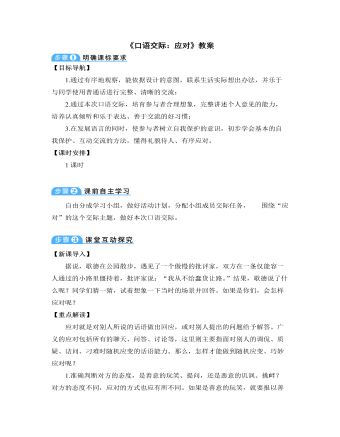
部编版语文八年级下册《口语交际:应对》教案
【研讨练习】题一:阅读下边的应对案例,简要说明这些名人采用了什么应对技巧。1.孔融十岁的时候就表现出超乎寻常的聪明才智,得到人们的赞许。有一个叫陈的官员却当众不以为然地说:“小时了了(聪明),大未必佳。”孔融立即回应道:“想君小时,必当了了。”2.一名英国女士非常喜欢钱钟书的小说《围城》,于是打电话给钱钟书请求见面。钱钟书对她说:“假如你吃了个鸡蛋觉得不错,何必认识那下蛋的母鸡呢?”3.一个年轻的画家拜访德国著名的画家阿道夫·门采尔,向他诉苦说:“我真不明白,为什么我画一幅画只用一会儿工夫,可卖出去要整整一年。”“请倒过来试试吧,”门采尔认真地说,“要是你花一年的工夫去画它,那么只用一天就准能卖掉它。”________________________________________________________________________________________________________________________________________参考答案:1.针锋相对2.归谬3.自嘲题二:在我们的生活当中,经常会碰到别人有意的嘲讽。阅读下面的情境,机智应对。
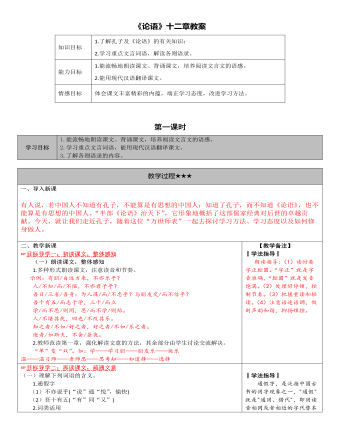
部编版语文七年级上册《论语》十二章教案
2.在新知与旧知、知识与实践的关系上,在学与思、学与问的关系上,孔子是怎么看的?新知与旧知的关系上,孔子认为“温故”可以“知新”。也只有“温故”“知新”的人才能当老师。这里,孔子强调的是“新知”,是那种开拓、创新的精神。在知识与实践的关系上,孔子认为“学而时习之”。学了知识要按时去实习,把所学的东西运用到行动上,在实践中提高对知识的掌握程度。在学与思的关系上,孔子认为学习与思考必须结合,二者缺一不可。只读书而不通过自己的头脑加以思考,就会感到迷惑;只是一味空想而不读书,就会精神疲惫。在学与问的关系上,孔子主张既学又问,不仅问知识才能比自己高的人,即使是知识才能比自己低的人,只要他们在某一方面有一技之长、一得之见,就应该虚心向他们求教,不以为羞耻。

